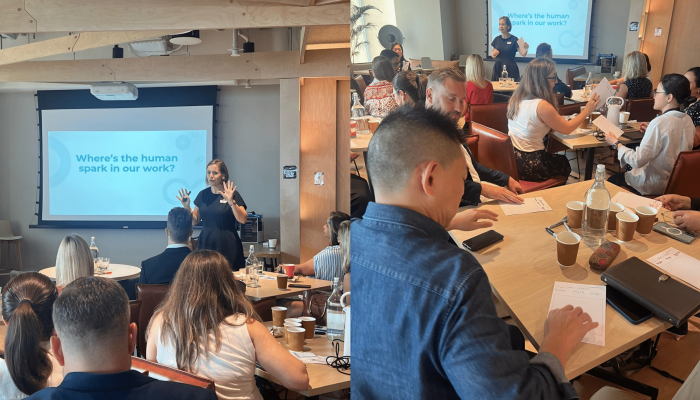Digital advertising is a double-edged sword. On one hand, it offers brands an unparalleled ability to reach and engage with their audience. On the other, if not used effectively, it can quickly become overwhelming and intrusive for consumers which therefore leads to disengagement.
This paradox was at the heart of our recent event, “Enrage or Engage: Navigating the Paradox of Digital Advertising,” and it’s something I’ve been reflecting on deeply. One of the biggest challenges we face today is the sheer volume of ads consumers are exposed to. According to SurveyMonkey, 74% of internet users globally feel overwhelmed by the number of ads they see online. This overexposure contributes to consumer frustration, reducing the impact of our advertising efforts and making it crucial for marketers to find ways to connect without causing irritation.
Marketers must ask how we engage without enraging
To bridge this gap, we need to explore the underlying complexities that drive the tension between engagement and annoyance. It’s not just the sheer volume of ads that creates problems but also how they are delivered, measured, and personalised. In this article, I dive into 6 areas that we as marketers need to be conscious of when engaging with the online population.
The Complexity Conundrum
The complexity of today’s AdTech environment only exacerbates the problem. Many marketers don’t fully understand these technological adjustments, leading to poor decisions and ultimately, ineffective campaigns. Transparency and attribution measurement are part of this complexity. Advertisers need to know where their money is going and how it’s performing, but this requires transparency from publishers, which often clashes with privacy concerns. Attribution measurement and transparency are mutually inclusive and without proper attribution, understanding campaign performance and using that data to improve ROI becomes nearly impossible.
Balancing Personalisation and Privacy
Another layer of complexity is the balance between personalisation and privacy. While personalisation enhances ad relevance, increasing privacy concerns cannot be ignored. Google’s hesitation in fully committing to a cookie-less future highlights the challenges. I am cynical about how much more privacy effort will actually be implemented. In a capitalist society, economic value often takes precedence over privacy. However, companies must find ways to target consumers within legal boundaries, ensuring that privacy measures are robust. Advertisers have a responsibility to respect consumer privacy while delivering personalised content that resonates.
Creative Strategies for Engagement
To prevent ads from becoming a source of frustration, creativity is essential. Dynamic Creative Optimisation (DCO) has emerged as a powerful tool, allowing us to tailor ads based on real-time factors like weather, language, and proximity. This keeps ads fresh and relevant without adding extra creative costs. By continuously adapting the content, we can ensure that ads remain engaging and avoid contributing to ad fatigue.
Aligning Marketing with Business Goals
Even the most creative strategies can fall flat if there’s a misalignment between marketing teams and overall business goals. Too often, senior managers lack up-to-date knowledge of current marketing trends, as their scope of responsibility shifts more and more into people management, they are now at risk of leading strategies that are no longer current or innovative. This misalignment results in an unhealthy cycle of ineffective campaigns, where neither the marketing team nor the management feels empowered to address the underlying issues.
Improving internal communication is crucial. One effective strategy is to involve management in vendor meetings, transforming these sessions into educational opportunities that align everyone’s understanding of the digital landscape. By fostering a collaborative learning culture, businesses can create more cohesive strategies that are better aligned with their goals and more likely to gain internal approval.
Choosing the Right Vendor
Choosing the right vendor can make all the difference, especially when the line between engaging and annoying your audience is so thin. It’s not just about a vendor’s past successes; it’s about their ability to understand your specific needs and apply industry best practices to meet your goals. The right vendor knows how to navigate the complexities of marketing, from acquisition to retention. By implementing strategies like DCO and personalised content, they can ensure that your campaigns resonate rather than frustrate. A vendor who aligns their approach with your objectives helps create meaningful connections at every touchpoint, turning potential pitfalls into opportunities for engagement and long-term success.
Maintaining Long-Term Engagement
Maintaining long-term customer engagement requires continuous effort. It requires continuous review and reflection on campaigns. It’s essential to review and reflect on campaign performance regularly. Quarterly business reviews are not just a formality; they’re a vital opportunity to assess the total attribution of your marketing efforts. Ensuring visibility across the entire consumer journey allows you to make strategic adjustments that enhance the overall consumer experience. When you take the time to review and optimise your efforts, you’re more likely to deliver a successful and quality experience for the consumer.
Final Thoughts
Navigating the paradox of digital advertising demands a thoughtful approach that balances engagement with respect for the consumer. We can transform the digital advertising landscape by addressing ad overexposure, simplifying AdTech integration, and focusing on relevant, personalised content. Aligning marketing strategies with business goals and leveraging vendor expertise empowers teams to create successful campaigns that resonate with consumers.
Our goal should be to create an advertising environment where consumers feel valued and engaged, not overwhelmed. As marketers, we must continuously adapt and innovate to meet business objectives while enhancing the consumer experience.
Authored by Frank Cheng, Senior Business Director, Asia, Crimtan
Published on 24 September 2024



